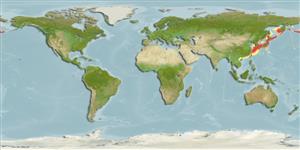Environment: milieu / climate zone / depth range / distribution range
Écologie
marin démersal; profondeur 15 - 800 m (Ref. 57942), usually 20 - 610 m (Ref. 50610). Temperate
Northwest Pacific: central Japan northward, southern Kuril Islands, Sakhalin, Sea of Japan, the Yellow Sea, Gulf of Bo Hai and East China Sea.
Taille / Poids / Âge
Maturity: Lm ? range ? - ? cm
Max length : 60.0 cm SL mâle / non sexé; (Ref. 559); poids max. publié: 1.8 kg (Ref. 40637)
Inhabits sand and mud bottoms (Ref. 9137, 11230).
Life cycle and mating behavior
Maturité | Reproduction | Frai | Œufs | Fécondité | Larves
Vinnikov, K.A., R.C. Thomson and T.A. Munroe, 2018. Revised classification of the righteye flounders (Teleostei: Pleuronectidae) based on multilocus phylogeny with complete taxon sampling. Molecular phylogenetics and evolution, 125:147-162. (Ref. 122998)
Statut dans la liste rouge de l'IUCN (Ref. 130435: Version 2024-2)
Menace pour l'homme
Harmless
Utilisations par l'homme
Pêcheries: commercial
Outils
Articles particuliers
Télécharger en XML
Sources Internet
Estimates based on models
Preferred temperature (Ref.
123201): 0.8 - 21.9, mean 8.6 °C (based on 1055 cells).
Phylogenetic diversity index (Ref.
82804): PD
50 = 0.5625 [Uniqueness, from 0.5 = low to 2.0 = high].
Bayesian length-weight: a=0.01202 (0.00678 - 0.02133), b=3.15 (2.99 - 3.31), in cm total length, based on LWR estimates for this species & (Sub)family-body (Ref.
93245).
Niveau trophique (Ref.
69278): 3.4 ±0.2 se; based on diet studies.
Generation time: 13.7 ( na - na) years. Estimated as median ln(3)/K based on 2
growth studies.
Résilience (Ref.
120179): Faible, temps minimum de doublement de population : 4,5 à 14 années (K=0.08-0.11).
Fishing Vulnerability (Ref.
59153): High to very high vulnerability (67 of 100).
